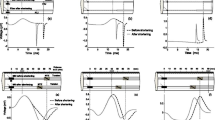Abstract
A model is constructed of the motor units in the human first dorsal interosseus (FDI) muscle. Each motorneuron is simulated using a pseudo-steady-state model that omits the membrane capacity and the events underlying the action potential. Properties of individual twitches in the corresponding muscle units are based on the data of Milner-Brown et al. for the FDI, while the transduction between steady firing rate and percentage of maximum tension in a muscle unit is based on the work of Rack and Westbury on the cat soleus muscle. Since we are concerned only with small isometric tensions, we ignore effects due to muscle spindles and to recurrent inhibition. The model allows one to to determine, by simulation, the tension-time functions produced by different “programs” of input to an entire pool of 120 motorneurons. Thus, for example, in order to produce tension rising linearly with time, it suffices to deliver to each neuron in the pool a non-linearly rising conductance; the conductance can be the same for all neurons in the pool, but can NOT be scaled in proportion to the surface area of the respective neurons. The input may be delivered to any part of the neuron's dendritic tree, as long as the electrotonic distribution of input is the same for all the neurons. For a linearly rising force produced in this way, most of the motorneurons yield similar slopes for their frequency-force curves, as observed by Milner-Brown et al. To produce tensions greater than about 1 kg, mechanisms not included in this model must come into play, i.e. perhaps introduction of phasic motorneurons. The most important data needed to improve this model are sets of isometric frequency-force curves for muscle units of different twitch tensions.
Similar content being viewed by others
References
Burke, R.E.: On the central nervous system control of fast and slow twitch motor units. In: Desmedt, J.E. (Ed.): New developments in electromyography and clinical neurophysiology, Vol. 3, pp. 69–94. Basel, Karger 1973
Burke, R.E., Edgerton, V.R.: Motor unit properties and selective involvement in movement. Exercise Sport Sci. Rev. 3, 31–81 (1975)
Dodge, F.A., Jr., Cooley, J.W.: Action potential of the motorneuron. IBM J. Res. Dev. 17, 219–229 (1973)
Eccles, R.M., Phillips, C.G., Chien-Ping, W.: Motor innervation, motor unit organization and afferent innervation of M. Extensor Digitorum Communis of the baboon's forearm. J. Physiol. 198, 179–192 (1968)
Feinstein, B., Lindegard, B., Nyman, E., Wohlfart, G.: Morphologic studies of motor units in normal human muscles. Acta Anat. 23, 127–142 (1955)
Kernell, D.: The limits of firing frequency in cat lumbosacral motoneurons possessing different time course of afterhyperpolarization. Acta Physiol. Scand. 65, 87–100 (1965)
Kernell, D.: Input resistance, electrical excitability and size of ventral horn cells in cat spinal cord. Science 152, 1637–1640 (1966)
McPhedran, A.M., Wuerker, R.B., Henneman, E.: Properties of motor units in a homogeneous red muscle (soleus) of the cat. J. Neurophysiol. 28, 71–84 (1965)
Milner-Brown, H.S., Stein, R.B., Yemm, R.: The contractile properties of human motor units during voluntary isometric contractions. J. Physiol. 228, 371–390 (1973a)
Milner-Brown, H.S., Stein, R.B., Yemm, R.: The orderly recruitment of human motor units during voluntary isometric contractions. J. Physiol. 230, 359–370 (1973b)
Milner-Brown, H.S., Stein, R.B., Yemm, R.: Changes in firing rate of human motor units during linearly changing voluntary contractions. J. Physiol. 230, 371–390 (1973c)
Milner-Brown, H.S., Stein, R.B., Lee, R.G.: Pattern of recruiting human motor units in neuropathies and motor neurone disease. J. Neurol. Neurosurg. Psychiat. 37, 665–669 (1974)
Rack, P. M. H., Westbury, D.R.: The effects of length and stimulus rate on tension in the isometric cat soleus muscle. J. Physiol. 204, 443–460 (1969)
Rall, W.: Theory of physiological properties of dendrites. Ann. N.Y. Acad. Sci. 96, 1071–1092 (1962)
Tanji, J., Kato, M.: Firing rate of individual motor units in voluntary contraction of abductor digiti minimi muscle in man. Exp. Neurol. 40, 771–783 (1973)
Traub, R.: Motorneurons of different geometry and the size principle. Biol. Cybernetics 25, 163–176 (1977)
Author information
Authors and Affiliations
Rights and permissions
About this article
Cite this article
Traub, R.D. A model of a human neuromuscular system for small isometric tensions. Biol. Cybernetics 26, 159–167 (1977). https://doi.org/10.1007/BF00365227
Received:
Issue Date:
DOI: https://doi.org/10.1007/BF00365227




